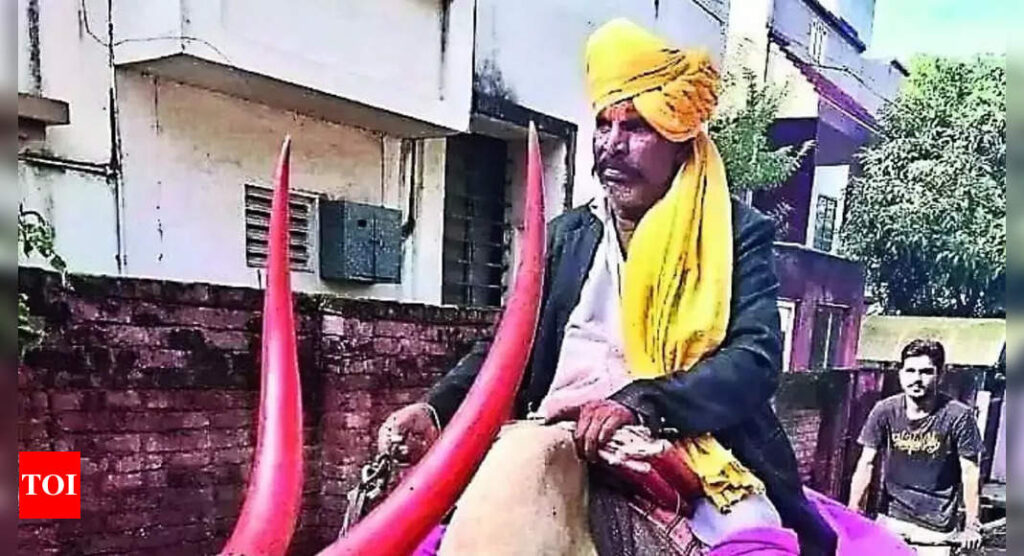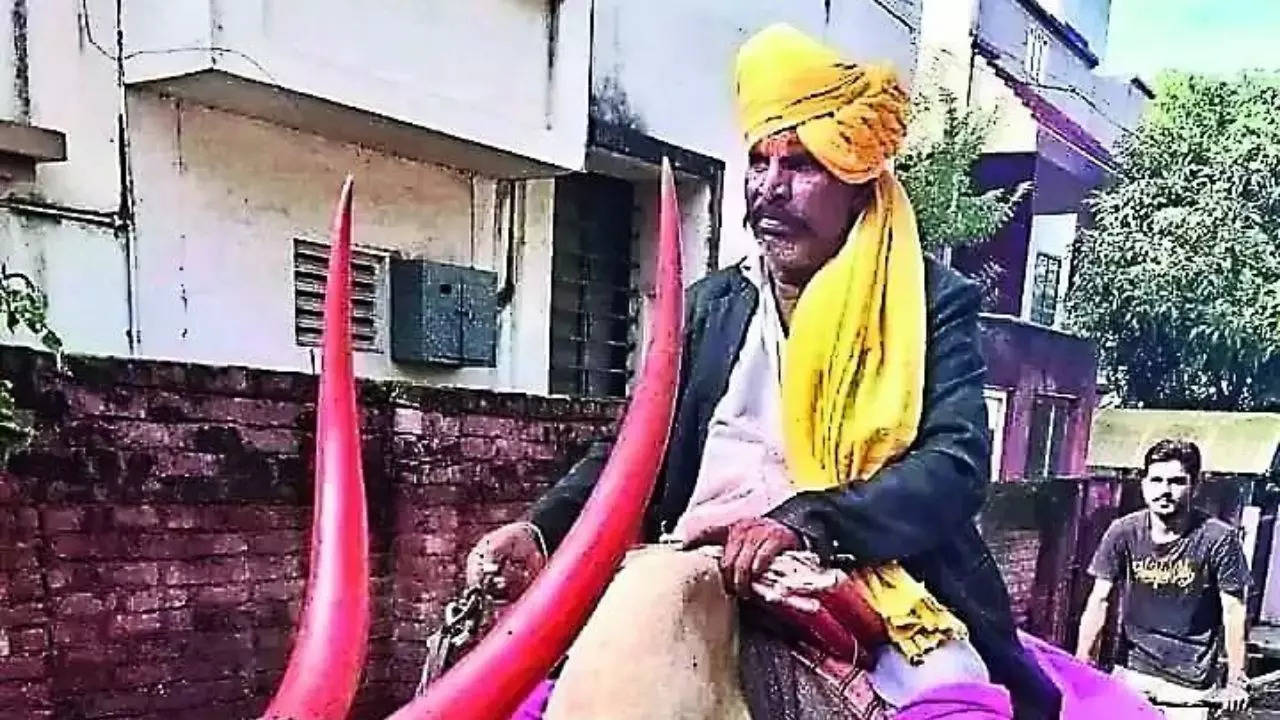[ad_1]
KOLHAPUR: Prakash Appaso Helavi’s days are hectic these days with requests pouring in from hundreds to trace their family roots, particularly if they have Kunbi lineage by any chance.
Ever since the Maharashtra government moved ahead on quota for Marathas with Kunbi lineage evidence, the phones of the Helavis, the tribe of family tree record-keepers, have not stopped ringing.Their references could provid vital clues to get official papers to prove the Marathas’ Kunbi status. Prakash (32) is a member of the tribe from the Maharashtra-Karnataka border. TheHelavis are maintaining such family records, dating back a few centuries, in western Maharashtra.
Prakash had seen his father and grandfather meeting one family after another in the villages of Chandgad tehsil in Kolhapur district after Diwali, seeking from them information related to births and deaths in the families and meticulously noting down all the details. Stepping out of home with ledgers having records of families Chandwad tehsil in Kolhapur has also been a usual feature in Prakash’s life every Diwali.
The demands for such work are much higher this Diwali. “The work makes me feel that I am carrying forward my family tradition,” says Prakash, a resident of Pattankudi village in Chikodi tehsil of Belagavi district.
With the demand for Maratha quota gaining steam, families are keen to find if the Helavis have any Kunbi reference in their records. These references will provide a vital clue to get official documents needed to prove the Marathas’ Kunbi status. Social media groups have also been formed to help people identify and contact their Helavis for a family history narration.
“Our family maintains records of 60-70 villages from Gadhinglaj taluka. We visit these families once a year and add names, birth dates of newborns or new brides. We also make note of those who have died. Most of the time, people are interested in knowing their family history, where their ancestors came from and what they did. This knowledge is now taking a new turn with the search for Kunbi references,” says Prakash.
Ajit Utturkar, a 47-year-old civil engineer from Kolhapur’s Ajara town, says, “Our family tree records obtained from Helavi show that we had moved from Panhala fort some nine generations ago. The records helped us understand where we came from and who were our ancestors. I have recently added the name of my children into the family tree with birth dates. I have taken a copy of the family record tree which I can use to find the old documents required for purposes such as property transfer.”
The family tree records are written in Modi, one of the oldest scripts of Marathi language which Prakash knows well enough though he didn’t go to school. “I learnt Marathi and Kannada from my father. He also taught me how to read and write in Modi script. Most importantly, he taught me how to present the family history to people searching for their roots,” Prakash says.
Though he rides a bike to reach the villages, his father’s mode of transport would be an oxen. Some elderly members of the tribe still use the oxen, making a grand announcement of their arrival in villages. The method of keeping the records has also changed over the years. The ‘tamrapat’ (copper plates) has given way to paper ledgers. Still, innumerable copper plates are stored at Mayakka Chinchali, a holy place in Raibag taluka of Karnataka. Shivaji Helavi, a 50-year-old resident of Belagavi district of Karnataka, says they have a sense of pride in the work done by their forefathers. Till a few years ago, the only time they would get a query was when there was sharing and transfer of property.
“Earlier, we used to get just one or two enquiries for the genealogy in a year. These days, I am getting over 10-20 enquiries from Marathas every day to visit them with their family tree. In the past records of Marathas, Kunbi is mentioned,” Shivaji says.
Some enthusiasts are helping the Maratha community members find their Helavi. Sunil Gaikwad from Khandala town of Satara district is one of them. He has started groups and pages on social media, called ‘Aapla Helavi’. He says, “Many don’t know the Helavi keeping their family record. Through social media, we are reaching out to the Helavis and the persons who need them for tracing family history.”
Though the Helavis are being called upon in the search for the Kunbi roots, these traditional records are, however, not useful in getting Kunbi certificates from the government. They can only give a clue to finding the Kunbi reference in government records.
Vasantrao Mulik, Kolhapur president of Maratha Mahasangh who is involved in helping Marathas find the Kunbi records for two decades, says only revenue documents, school leaving certificates and birth and death certificates of one’s ancestors are considered valid. “We can get the details of the past two to three generations from these documents. However, the genealogy from the records with Helavis can be a strong ,” he says.
Ever since the Maharashtra government moved ahead on quota for Marathas with Kunbi lineage evidence, the phones of the Helavis, the tribe of family tree record-keepers, have not stopped ringing.Their references could provid vital clues to get official papers to prove the Marathas’ Kunbi status. Prakash (32) is a member of the tribe from the Maharashtra-Karnataka border. TheHelavis are maintaining such family records, dating back a few centuries, in western Maharashtra.
Prakash had seen his father and grandfather meeting one family after another in the villages of Chandgad tehsil in Kolhapur district after Diwali, seeking from them information related to births and deaths in the families and meticulously noting down all the details. Stepping out of home with ledgers having records of families Chandwad tehsil in Kolhapur has also been a usual feature in Prakash’s life every Diwali.
The demands for such work are much higher this Diwali. “The work makes me feel that I am carrying forward my family tradition,” says Prakash, a resident of Pattankudi village in Chikodi tehsil of Belagavi district.
With the demand for Maratha quota gaining steam, families are keen to find if the Helavis have any Kunbi reference in their records. These references will provide a vital clue to get official documents needed to prove the Marathas’ Kunbi status. Social media groups have also been formed to help people identify and contact their Helavis for a family history narration.
“Our family maintains records of 60-70 villages from Gadhinglaj taluka. We visit these families once a year and add names, birth dates of newborns or new brides. We also make note of those who have died. Most of the time, people are interested in knowing their family history, where their ancestors came from and what they did. This knowledge is now taking a new turn with the search for Kunbi references,” says Prakash.
Ajit Utturkar, a 47-year-old civil engineer from Kolhapur’s Ajara town, says, “Our family tree records obtained from Helavi show that we had moved from Panhala fort some nine generations ago. The records helped us understand where we came from and who were our ancestors. I have recently added the name of my children into the family tree with birth dates. I have taken a copy of the family record tree which I can use to find the old documents required for purposes such as property transfer.”
The family tree records are written in Modi, one of the oldest scripts of Marathi language which Prakash knows well enough though he didn’t go to school. “I learnt Marathi and Kannada from my father. He also taught me how to read and write in Modi script. Most importantly, he taught me how to present the family history to people searching for their roots,” Prakash says.
Though he rides a bike to reach the villages, his father’s mode of transport would be an oxen. Some elderly members of the tribe still use the oxen, making a grand announcement of their arrival in villages. The method of keeping the records has also changed over the years. The ‘tamrapat’ (copper plates) has given way to paper ledgers. Still, innumerable copper plates are stored at Mayakka Chinchali, a holy place in Raibag taluka of Karnataka. Shivaji Helavi, a 50-year-old resident of Belagavi district of Karnataka, says they have a sense of pride in the work done by their forefathers. Till a few years ago, the only time they would get a query was when there was sharing and transfer of property.
“Earlier, we used to get just one or two enquiries for the genealogy in a year. These days, I am getting over 10-20 enquiries from Marathas every day to visit them with their family tree. In the past records of Marathas, Kunbi is mentioned,” Shivaji says.
Some enthusiasts are helping the Maratha community members find their Helavi. Sunil Gaikwad from Khandala town of Satara district is one of them. He has started groups and pages on social media, called ‘Aapla Helavi’. He says, “Many don’t know the Helavi keeping their family record. Through social media, we are reaching out to the Helavis and the persons who need them for tracing family history.”
Though the Helavis are being called upon in the search for the Kunbi roots, these traditional records are, however, not useful in getting Kunbi certificates from the government. They can only give a clue to finding the Kunbi reference in government records.
Vasantrao Mulik, Kolhapur president of Maratha Mahasangh who is involved in helping Marathas find the Kunbi records for two decades, says only revenue documents, school leaving certificates and birth and death certificates of one’s ancestors are considered valid. “We can get the details of the past two to three generations from these documents. However, the genealogy from the records with Helavis can be a strong ,” he says.
[ad_2]
Source link











More Stories
We can’t wait to face India in the final: Pat Cummins | Cricket News
Railways plans 3,000 additional trains in next 4-5 years to minimise number of waitlisted tickets | India News
Faridabad: Man dies after ‘falling from hotel room window’ while partying with friends